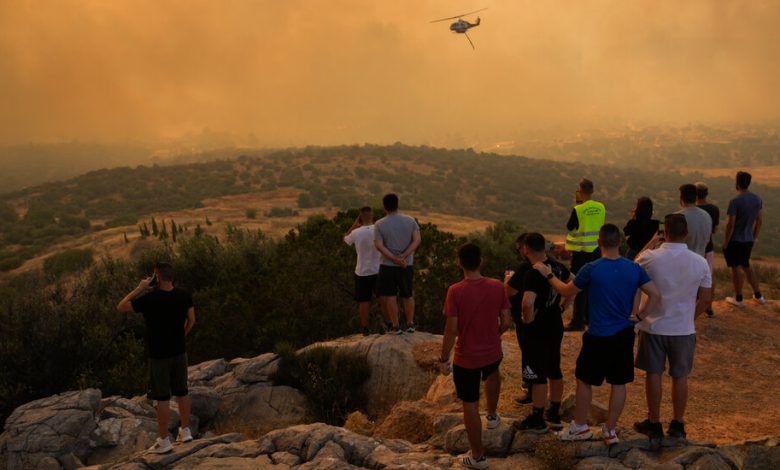Heat Waves Grip 3 Continents as Climate Change Warms Earth

Punishing heat waves gripped three continents on Tuesday, breaking records in cities around the Northern Hemisphere less than two weeks after the Earth recorded what scientists said were likely its hottest days in modern history.
Firefighters in Greece scrambled to put out wildfires, as parched conditions raised the risk of more blazes throughout Europe. Beijing logged another day of 95-degree heat, and people in Hangzhou, another Chinese city, compared the choking conditions to a sauna. From the Middle East to the American Southwest, delivery drivers, airport workers and construction crews labored under blistering skies. Those who could stay indoors did.
The temperatures, afflicting so much of the world all at once, were a withering reminder that climate change is a global crisis, driven by human-made forces: the emissions of heat-trapping gases, mainly caused by the burning of fossil fuels.
John Kerry, the U.S. special envoy for climate change, sought to coordinate some of the global response with the Chinese premier in Beijing, as a heat wave clutched a huge swath of China.
“The world really is looking to us for that leadership, particularly on the climate issue,” Mr. Kerry told Chinese officials. “Climate, as you know, is a global issue, not a bilateral issue. It’s a threat to all of humankind.”
The planet has warmed about 2 degrees Fahrenheit since the 19th century and will continue to grow hotter until humans essentially stop burning coal, oil and gas, scientists say. The warmer temperatures contribute to extreme weather events and help make periods of extreme heat more frequent, longer and more intense.
Also affecting this year’s conditions is the return of El Niño, a cyclical weather pattern that, depending on the sea surface temperature and the pressure of the air above it, can originate in the Pacific and have wide-ranging effects on weather around the world.
For hundreds of millions of people on Tuesday, the heat was hard to escape. In the United States, Phoenix broke a nearly half-century-old record on Tuesday, with the city’s 19th consecutive day of temperatures above 110 degrees Fahrenheit (43.3 Celsius). Elsewhere around the country, hot and humid conditions were expected to worsen along the Gulf Coast and throughout the Southeast.
Wildfires raged on for yet another week in Canada, having burned a staggering 25 million acres so far this year, an area roughly the size of Kentucky. With more than a month of peak fire season to go, 2023 has already eclipsed Canada’s annual record, from 1989.
Fires also forced evacuations in villages south, west and north of Athens, burning an estimated 7,400 acres of forest in Greece despite aerial water bombardments to bring the blazes under control.
“We’ve had fires, we have them now and we’ll have them in the future, and this is one of the consequences of the climate crisis that we are living with ever greater intensity,” Prime Minister Kyriakos Mitsotakis said in a statement.
Mr. Mitsotakis cut short a trip to meet European leaders in Brussels in order to oversee the firefighting. The Greek authorities, who opened air-conditioned venues in Athens to offer some relief, are also expected to restrict access to the Acropolis to cooler morning and afternoon hours, as they did last weekend after a tourist collapsed.
In many European cities, officials have introduced cooling stations. And mindful of the danger — more than 61,000 people died in last summer’s heat waves in Europe, according to a recent study — they have urged visitors and residents alike to stay indoors during the day’s hottest hours.
In Rome, where the temperatures surpassed 100 Fahrenheit (37.8 Celsius) on Tuesday, officials mobilized a task force to hand out water and help people suffering from heat stress at sites like the Colosseum and outdoor markets.
The Japanese authorities, similarly, have rushed to help people suffering from the heat: At a festival in Kyoto on Monday, nine people, ranging in age from 8 to more than 80, were taken to a hospital as temperatures neared 100 degrees Fahrenheit. In Toyota City in Aichi Prefecture, where the temperature hit more than 102 degrees Fahrenheit, the regional board of education urged 415 elementary and middle schools to cancel gym classes and outdoor activities.
And in China, where a series of heat waves have seared the country since late June, Beijing and other cities have recorded day after day of heat over 90 degrees.
Power stations, in turn, have broken records for generating electricity, according to the official China Energy News — burning more coal to meet demand for cooling. China uses considerable solar, wind and hydro power, but still relies on coal for three-fifths of its electricity. Some internet users in two provinces, Guangdong and Sichuan, reported scattered blackouts this week; state media, which tends to be slow to acknowledge power problems, has been silent about blackouts.
For millions of people in South and Southeast Asia, the stifling heat began long before the summer. India recorded the hottest February in its history, then endured high temperatures in April, when 11 people died of heat stroke on a single day, and again in May and June. Monsoon rains cooled temperatures across the country only in recent weeks.
Even regions where high heat is normal — and where those who can afford to barely venture outside in the summer — have been experiencing extremes.
At Persian Gulf International Airport on Iran’s southwestern coast, the heat index — which measures how hot it really feels outside based on both temperature and humidity — hit an extraordinary high of 152 degrees Fahrenheit (66.7 Celsius) at 12:30 p.m. on Sunday, according to weather data. The combination of 104-degree heat and soaked air, with 65 percent humidity, pushed conditions at the airport beyond what scientists have said humans can normally withstand.
In Death Valley National Park in California, the thermometer read just over 128 degrees (53 Celsius) on Sunday.
It was in Death Valley, the 3,000-square-mile stretch of the Mojave Desert along the California-Nevada border, where the highest temperature was ever recorded on earth, according to the World Meteorological Organization. In 1913 in Furnace Creek, Calif., the temperature reached 134 degrees Fahrenheit, or 56.6 Celsius.
In recent years, thermometers there have come close, hitting 130 degrees Fahrenheit in 2020 and 2021, and forecasters warned it could near the mark again this summer. But this week at least, the National Weather Service forecast that temperatures in the national park should ease, relatively speaking, to 122 to 125 degrees Fahrenheit.
Vivian Yee, Shawn Hubler, Raymond Zhong, Stanley Reed, Patricia Cohen, Isabella Kwai, Niki Kitsantonis, Jacey Fortin, John Yoon, Vivian Wang, Lisa Friedman, Nadja Popovich, Hisako Ueno, Hikari Hida, Motoko Rich, Erin McCann, Anushka Patil and Chris Stanford contributed reporting.




